Students must practice these Maths 1B Important Questions TS Inter 1st Year Maths 1B Pair of Straight Lines Important Questions to help strengthen their preparations for exams.
TS Inter 1st Year Maths 1B Pair of Straight Lines Important Questions
Question 1.
If ‘θ’ is the acute angle between the lines represented by ax2 + 2hxy + by2 = 0 then, show that cos θ = \(\frac{|a+b|}{\sqrt{(a-b)^2+4 h^2}}\). [Mar. ’18 (TS); Mar. ’06; May ’97]
Solution:
Let ax2 + 2hxy + by2 = 0 represent the lines
l1x + m1y = 0 ……..(1)
l2x + m2y = 0 ……..(2)
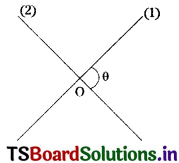
The combined equation of lines (1) & (2) is
ax2 + 2hxy + by2 = (l1x + m1y)(l2x + m2y)
= l1l2x2 + m1m2xy + l2m1xy + m1m2y2
= l1l2x2 + (l1m2 + l2m1)xy + m1m2y2
Comparing on both sides we get l1l2 = a, l1m2 + l2m1 = 2h, m1m2 = b
If θ is an angle between the lines (1) & (2)

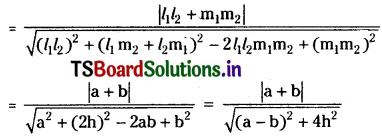
Question 2.
If the equation ax2 + 2hxy + by2 = 0 represents a pair of lines then prove that the equation of the pair of angular bisectors is h[x2 – y2] = (a – b) xy. [Mar. ’18 (AP); May ’13, ’09, ’96, ’91; Mar. ’13(old), ’09, ’00, ’95. ’92, ’90]
Solution:
Let ax2 + 2hxy + by2 = 0 represent a pair of straight lines
l1x + m1y = 0 ……(1)
l2x + m2y = 0 ……(2)
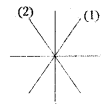
The combined equation of (1) & (2) is
ax2 + 2hxy + by2 = (l1x + m1y)(l2x + m2y)
= l1l2x2 + l1m2xy + l2m1xy + m1m2y2
= l1l2x2 + (l1m2 + l2m1)xy + m1m2y2
Comparing on both sides we get a = l1l2, 2h = l1m2 + l2m1, b = m1m2
The equation for the bisectors of angles between (1) & (2) is
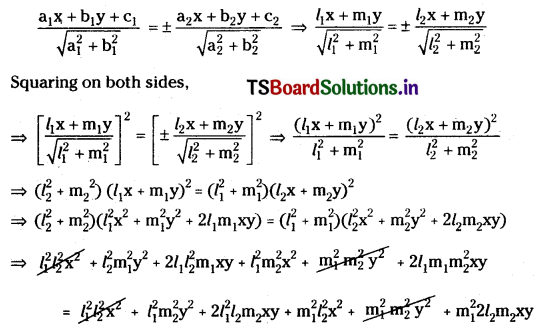
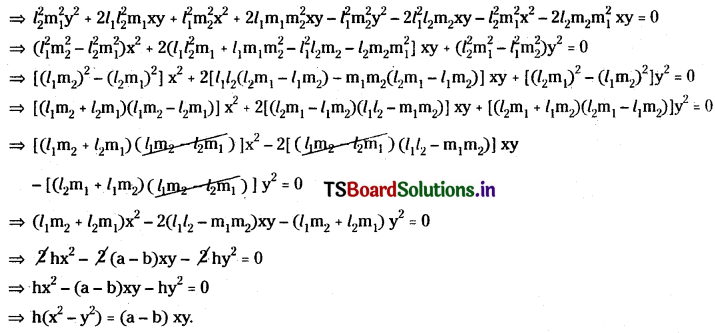
![]()
Question 3.
Show that the product of the perpendicular distances from a point (α, β) to the pair of straight lines ax2 + 2hxy + by2 = 0 is \(\frac{\left|a \alpha^2+2 h \alpha \beta+b \beta^2\right|}{\sqrt{(a-b)^2+4 h^2}}\). [May ’15 (AP); May ’14, ’13 (Old); ’11, ’08, ’07: Mar. ’08, ’07, ’04, ’01]
Solution:
Let ax2 + 2hxy + by2 = 0 represents two lines (1)&(2)
l1x + m1y = 0 …..(1), l2x + m2y = 0 ……(2)
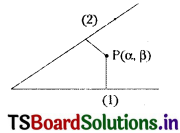
The combined equation of (1) & (2) is ax2 + 2hxy + by2
= (l1x + m1y)(l2x + m2y)
= l1l2x2 + l1m2xy + l2m1xy + m1m2y2
= l1l2x2 + (l1m2 + l2m1)xy + m1m2y2
Comparing on both sides we get a = l1l2, 2h = l1m2 + l2m1, b = m1m2
The length of the perpendicular from (α, β) to line (1) is
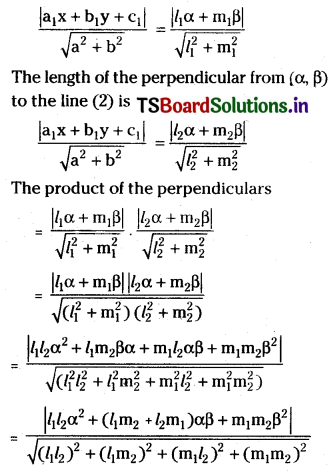
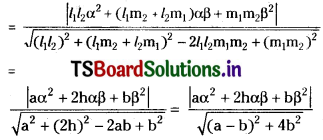
Question 4.
Show that the area of the triangle formed by the lines ax2 + 2hxy + by2 = 0 and lx + my + n = 0 is \(\frac{n^2 \sqrt{h^2-a b}}{\left|a m^2-2 h l m+b l^2\right|}\). [Mar. ’13, ’02; May ’15(TS), ’10, ’98, ’94, ’92; B.P; Mar. ’17 (AP & TS); Mar. ’19 (TS)]]
Solution:
Let ax2 + 2hxy + by2 = 0 represents two lines l1x + m1y = 0 …….(1), l2x + m2y = 0 ……..(2)
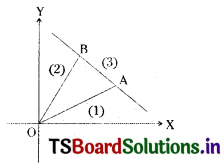
The combined equation of (1) & (2) is
ax2 + 2hxy + by2 = (l1x + m1y)(l2x + m2y)
= l1l2x2 + l1m2xy + l2m1xy + m1m2y2
= l1l2x2 + (l1m2 + l2m1)xy + m1m2y2
Comparing on both sides we get a = l1l2, 2h = l1m2 + l2m1, b = m1m2
Let the given line be lx + my + n = 0 ……..(3)
Clearly, the origin O is the point of intersection of (1) & (2)
∴ O = (0, 0)
Let A be the point of intersection of (1) & (3)
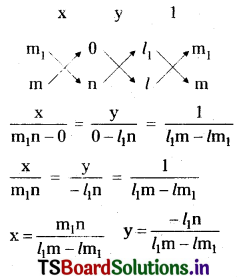
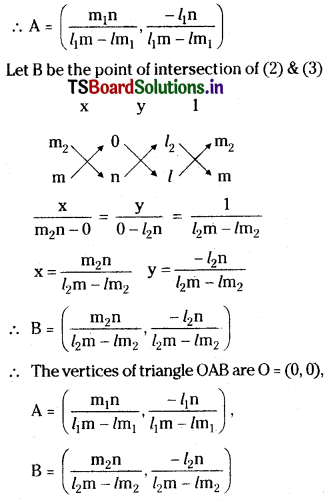
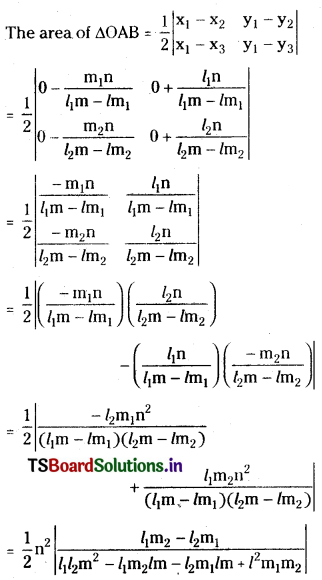
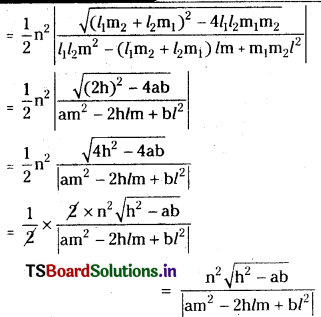
Question 5.
Find the centroid and area of the triangle formed by the lines 12x2 – 20xy + 7y2 – 0 and 2x – 3y + 4 = 0. [Mar. ’05, ’90, ’83; May ’87]
Solution:
Given the equation of the pair of lines is
12x2 – 20xy + 7y2 = 0
12x2 – 6xy – 14xy + 7y2 = 0
6x(2x – y) – 7y(2x – y) = 0
(2x – y)(6x – 7y) = 0
2x – y = 0 …….(1), 6x – 7y = 0 ……..(2)
The third equation is 2x – 3y + 4 = 0 ……(3)
∴ Vertex O: The point of intersection of (1) & (2) is O = (0, 0)
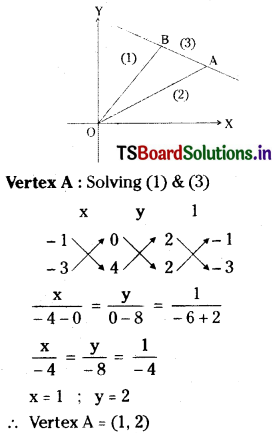
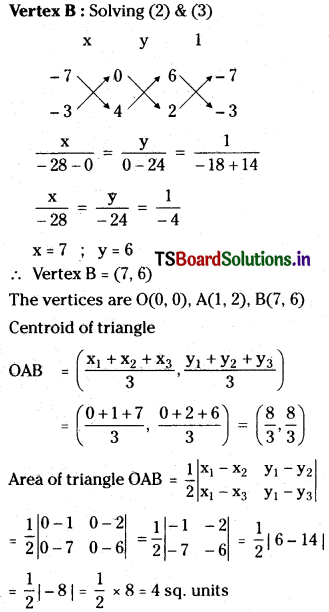
![]()
Question 6.
Show that the lines represented by (lx + my)2 – 3(mx – ly)2 = 0 and lx + my + n = 0 form an equilateral triangle with area \(\frac{n^2}{\sqrt{3}\left(l^2+m^2\right)}\). [Mar. ’15 (TS), ’91]
Solution:
Given equation of the pair of lines is (lx + my)2 – 3(mx – ly)2 = 0
(lx + my)2 – [√3(mx – ly)2] = 0
(lx + my + √3(mx – ly)) (lx + my – √3(mx – ly)) = 0
(lx + my + √3mx – √3ly) (lx + my – √3mx + √3ly) = 0
[(l + √3m)x + (m – √3l)y] [(l – √3m)x + (m + √3l)y] = 0
(l + √3m)x + (m – √3l)y = 0
(l – √3m)x + (m + √3l)y = 0
∴ This equation represents the lines
(l + √3m)x + (m – √3l)y = 0 ……..(1)
(l – √3m)x + (m + √3l)y = 0 ……(2)
Let the given equation of the straight line is lx + my + n = 0 ………(3)
If A is an angle between lines (1) & (3), then
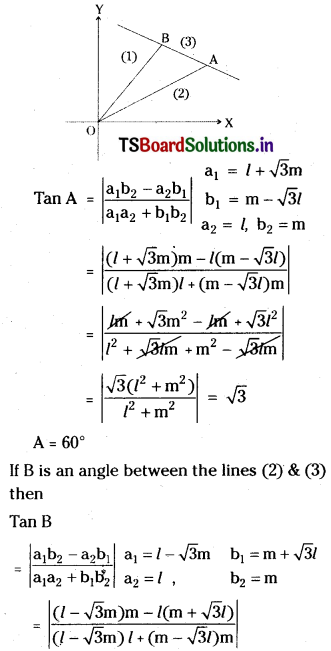
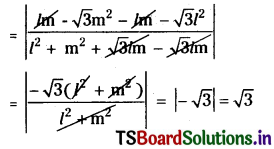
B = 60°
If O is the third angle then O = 180° – (60 + 60)
= 180° – 120°
= 60°
∴ A = B = O = 60°
The lines (1), (2), (3) form an equilateral triangle.
Now h = the perpendicular distance from the origin to the straight line lx + my + n = 0
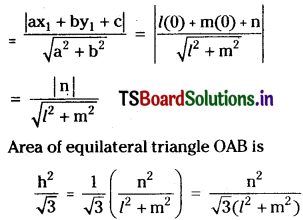
Question 7.
Prove that the lines represented by the x2 – 4xy + y2 = 0 and x + y = 3 form an equilateral triangle. [May ’00]
Solution:
Given the equation of the pair of lines is x2 – 4xy + y2 = 0
Comparing with ax2 + 2hxy + by2 = 0, we get a = 1, b = 1, h = -2.
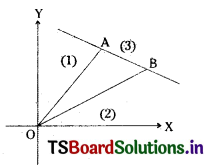
∴ Given equation represents the two lines are \(a x+\left(h \pm \sqrt{h^2-a b}\right) y=0\)
\(1 x+\left(-2 \pm \sqrt{(-2)^2-1 \times 1}\right) y=0\)
x + (-2 ± \(\sqrt{4-1}\))y = 0
x + (-2 ± √3)y = 0
x + (-2 + √3)y = 0, x + (-2 – √3)y = 0
This equation represents the lines
x + (-2 + √3)y = 0 ………(1)
x + (-2 – √3)y = 0 ………(2)
Let the given equation of the straight line is x + y – 3 = 0 ……(3)
Let A is an angle between (1) & (3) then
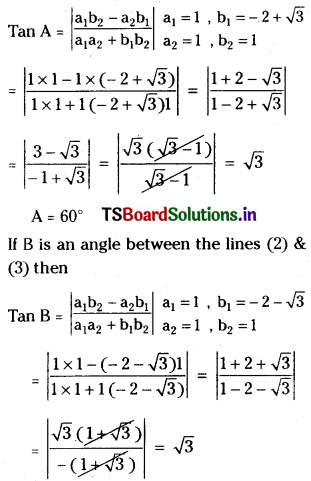
B = 60°
If O is the third angle then
O = 180° – (A + B)
= 180° – (60 + 60)
= 180° – 120°
= 60°
∴ O = A = B = 60°
∴ The lines (1), (2), (3) form an equilateral triangle.
![]()
Question 8.
If (α, β) is the centroid of the triangle formed by the lines ax2 + 2hxy + by2 = 0 and lx + my = 1 prove that \(\frac{\alpha}{b l-h m}=\frac{\beta}{a m-h l}=\frac{2}{3\left(b l^2-2 h l m+a m^2\right)}\). [Mar. ’08]
Solution:
Let ax2 + 2hxy + by2 = 0 represents the lines l1x + m1y = 0 …….(1), l2x + m2y = 0 ……(2)
∴ ax2 + 2hxy + by2 = (l1x + m1y)(l2x + m2y)
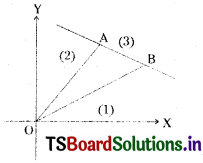
Comparing on both sides we get l1l2 = a, (l1m2 + l2m1) = 2h, m1m2 = b
Given equation of the straight line is lx + my – 1 = 0 ………(3)
Vertex O: Clearly the origin O is the point of intersection of (1) & (2)
∴ O = (0, 0)
Vertex A: Solving (2) & (3)
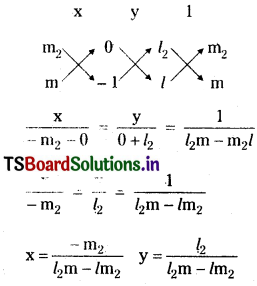
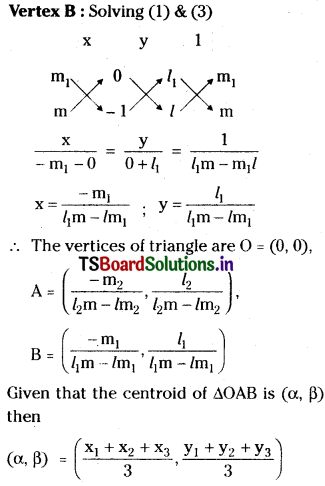
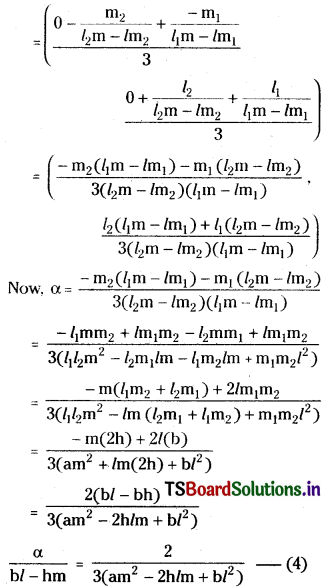
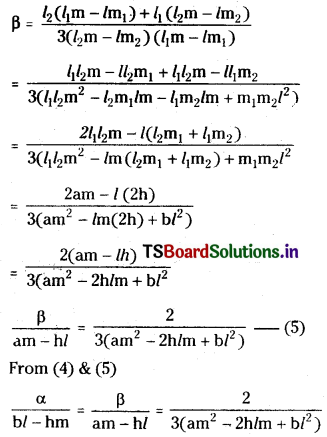
Question 9.
Find the equation of the pair of lines intersecting at (2, -1) and (i) perpendicular to the pair 6x2 – 13xy – 5y2 = 0 and (ii) parallel to the pair 6x2 – 13xy – 5y2 = 0. [May ’98]
Solution:
Given the equation of the pair of lines is 6x2 – 13xy – 5y2 = 0.
Comparing with ax2 + 2hxy + by2 = 0, we get a = 6, h = \(\frac{-13}{2}\), b = -5
Let the given point A(x1, y1) = (2, -1)
(i) Equation to the pair of lines perpendicular to 6x2 – 13xy – 5y2 = 0 and passing through (2, -1) is
b(x – x1)2 – 2h(x – x1)(y – y1) + a(y – y1)2 = 0
-5(x – 2)2 – 2 × \(\frac{-13}{2}\) (x – 2)(y + 1) + 6(y + 1)2 = 0
-5(x2 + 4 – 4x) + 13(xy + x – 2y – 2) + 6(y2 + 1 + 2y) = 0
-5x2 – 20 + 20x + 13xy + 13x – 26y – 26 + 6y2 + 6 + 12y = 0
-5x2 + 13xy + 6y2 + 33x – 14y – 40 = 0
5x2 – 13xy – 6y2 – 33x + 14y + 40 = 0
(ii) Equation to the pair of a line parallel to 6x2 – 13xy – 5y2 = 0 and passing through (2, -1) is
a(x – x1)2 + 2h(x – x1)(y – y1) + b(y – y1)2 = 0
6(x – 2)2 + 2 × \(\frac{-13}{2}\) (x – 2) (y + 1) – 5(y + 1)2 = 0
6(x2 + 4 – 4x) – 13(xy + x – 2y – 2) – 5(y2 + 1 + 2y) = 0
6x2 + 24 – 24x – 13xy – 13x + 26y + 26 – 5y2 – 5 – 10y = 0
6x2 – 5y2 – 13xy – 37x + 16y + 45 = 0
Question 10.
If ax2 + 2hxy + by2 + 2gx + 2fy + c = 0 represents a pair of lines then prove that
(i) abc + 2fgh – af2 – bg2 – ch2 = 0
(ii) h2 ≥ ab, g2 ≥ ac and f2 ≥ bc. [Mar. ’16 (AP & TS), ’14, ’11, ’96, ’83; May ’95, ’90]
Solution:
Let ax2 + 2hxy + by2 + 2gx + 2fy + c = 0 represent the two lines
l1x + m1y + n1 = 0 ……….(1)
l2x + m2y + n2 = 0 ……….(2)
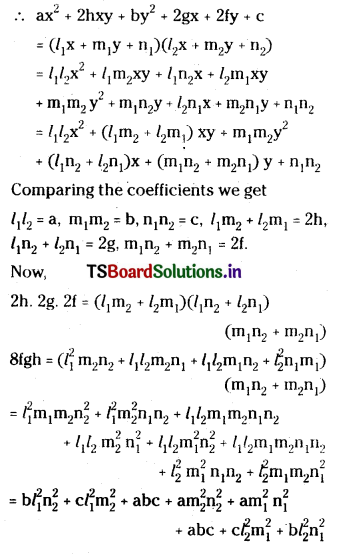
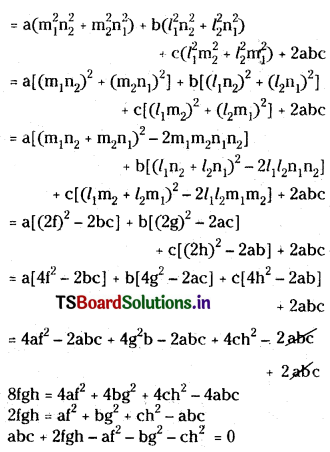
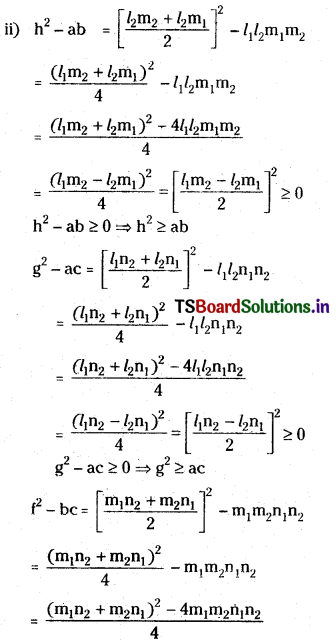

Question 11.
If the equation ax2 + 2hxy + by2 + 2gx + 2fy + c = 0 represents two parallel lines, then prove that (i) h2 = ab (ii) af2 = bg2 and (iii) the distance between the parallel lines = \(2 \sqrt{\frac{g^2-a c}{a(a+b)}}=2 \sqrt{\frac{f^2-b c}{b(a+b)}}\). [Mar. ’12, ’10, ’98; May ’06, ’01, ’97, ’95, ’91; Mar. ’19 (AP)]
Solution:
Let S = 0 represent the lines
lx + my + n1 = 0 …….(1)
lx + my + n2 = 0 …….(2)
∴ ax2 + 2hxy + by2 + 2gx + 2fy + c = (lx + my + n1)(lx + my + n2)
= l2x2 + lmxy + ln2x + lmxy + m2y2 + mn2y + ln1x + mn1y + n1n2
= l2x2 + 2lmxy + m2y2 + (ln2 + ln1)x + (mn2 + mn1)y + n1n2
Comparing both sides we get
l2 = a, 2lm = 2h, m2 = b, ln1 + ln2 = 2g, mn2 + mn1 = 2f, n1n2 = c, lm = h, l(n1 + n2) = 2g
m(n1 + n2) = 2f
(i) h2 = (lm)2 = l2m2 = ab = R.H.S.
∴ h2 = ab
(ii) \(\frac{2g}{2f}\) = \(\frac{l\left(n_1+n_2\right)}{m\left(n_1+n_2\right)}\)
\(\frac{\mathrm{g}}{\mathrm{f}}=\frac{l}{\mathrm{~m}}\)
gm = lf
Squaring on both sides
g2m2 = l2f2
∴ af2 = bg2
(iii) The distance between two parallel lines
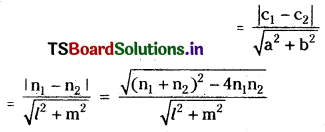
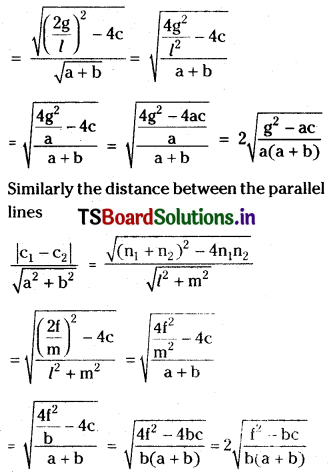
![]()
Question 12.
Show that the equation 2x2 – 13xy – 7y2 + x + 23y – 6 = 0 represents a pair of straight lines. Also, find the angle between them and the coordinates of the point of intersection of the lines. [May ’12, ’00; Mar. ’03]
Solution:
Given equation is 2x2 – 13xy – 7y2 + x + 23y – 6 = 0.
Comparing the given equation with ax2 + 2hxy + by2 + 2gx + 2fy + c = 0, we get
a = 2, h = \(\frac{-13}{2}\), b = -7, g = \(\frac{1}{2}\), f = \(\frac{23}{2}\), c = -6
Now,
(i) abc + 2fgh – af2 – bg2 – ch2
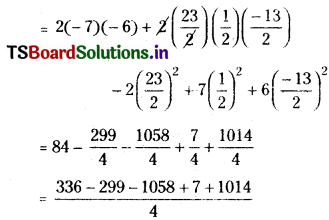
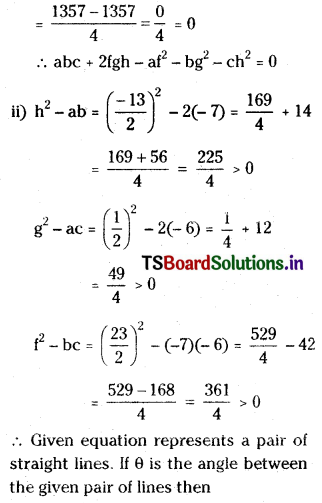
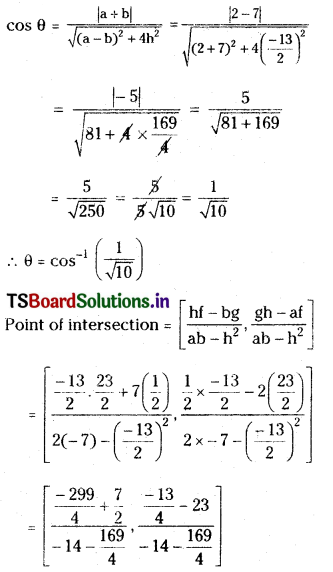
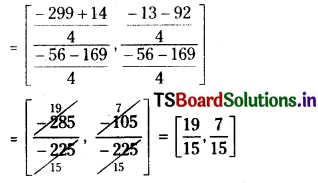
Question 13.
Find the value of λ for which the equation λx2 – 10xy + 12y2 + 5x – 16y – 3 = 0 represents a pair of straight lines. [May ’09]
Solution:
Given equation is λx2 – 10xy + 12y2 + 5x – 16y – 3 = 0.
Comparing the given equation with ax2 + 2hxy + by2 + 2gx + 2fy + c = 0, we get
a = λ, h = -5, b = 12, g = \(\frac{5}{2}\), f = -8, c = -3
Since the given equation represents a pair of straight lines then
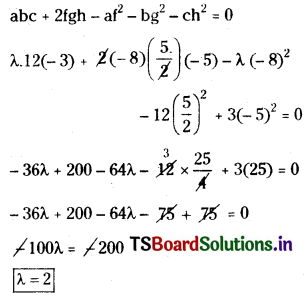
Question 14.
Show that the equation 8x2 – 24xy + 18y2 – 6x + 9y – 5 = 0 represents a pair of parallel straight lines and find the distance between them. [Mar. ’93]
Solution:
Given, equation is 8x2 – 24xy + 18y2 – 6x + 9y – 5 = 0
Comparing the given equation with ax2 + 2hxy + by2 + 2gx + 2fy + c = 0, we get
a = 8, h = -12, b = 18, g = -3, f = \(\frac{9}{2}\), c = -5
(i) h2 = ab
⇒ h2 = (-12)2 = 144
ab = 8 × 18 = 144
∴ h2 = ab
(ii) af2 = \(8\left(\frac{9}{2}\right)^2\)
= 8 × \(\frac{81}{4}\)
= 162
bg2 = 18(-3)2
= 18 × 9
= 162
∴ af2 = bg2
∴ The given equation represents a pair of parallel straight lines.
Now the distance between the parallel lines
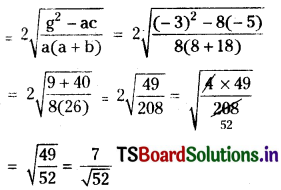
Question 15.
Show that the pairs of straight lines 6x2 – 5xy – 6y2 = 0 and 6x2 – 5xy – 6y2 + x + 5y – 1 = 0 form a square. [May ’02, ’98, ’91, ’86: Mar. ’02]
Solution:
Given equations of the pair of lines are
6x2 – 5xy – 6y2 = 0 ……..(1)
6x2 – 5xy – 6y2 + x + 5y – 1 = 0 ………(2)
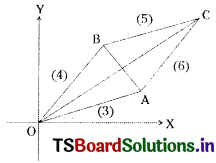
Now, 6x2 – 5xy – 6y2 = 0
6x2 – 9xy + 4xy – 6y2 = 0
3x(2x – 3y) + 2y(2x – 3y) = 0
(2x – 3y)(3x + 2y) = 0
2x – 3y = 0 …….(3) 3x + 2y = 0 ……..(4)
Equation (1) represents the two lines are 2x – 3y = 0 ……(3), 3x + 2y = 0 …….(4)
Now, 6x2 – 5xy – 6y2 + x + 5y – 1 = (2x – 3y + k) (3x + 2y + l)
Comparing the coefficient of x on both sides we get 2l + 3k = 1
Comparing the coefficient of y on both sides we get -3l + 2k = 5
Solving these two equations
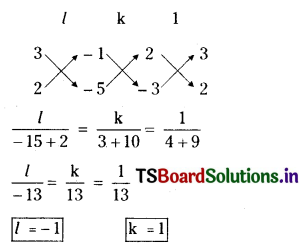
Equation (2) represents the lines that are
2x – 3y + 1 = 0
3x + 2y – 1 = 0
∴ The four lines are
2x – 3y = 0 ……(3)
3x + 2y = 0 ……..(4)
2x – 3y + 1 = 0 ……..(5)
3x + 2y – 1 = 0 ………(6)
The equations (3) & (5); (4) & (6) are parallel.
The equations (3) & (4); (5) & (6) are perpendicular.
∴ The four lines form a rectangle.
The distance between the parallel lines (3) & (5) is
\(\frac{\left|c_1-c_2\right|}{\sqrt{a^2+b^2}}=\frac{|0-1|}{\sqrt{2^2+(-3)^2}}=\frac{|-1|}{\sqrt{4+9}}=\frac{1}{\sqrt{13}}\)
The distance between the parallel lines (4) & (6) is
\(\frac{\left|c_1-c_2\right|}{\sqrt{a^2+b^2}}=\frac{|0+1|}{\sqrt{3^2+2^2}}=\frac{1}{\sqrt{9+4}}=\frac{1}{\sqrt{13}}\)
∴ Given lines form a square.
![]()
Question 16.
Show that the straight lines y2 – 4y + 3 = 0 and x2 + 4xy + 4y2 + 5x + 10y + 4 = 0 form a parallelogram and find the lengths of its sides. [Mar. ’92]
Solution:
Given equations of the straight lines are
y2 – 4y + 3 = 0 …….(1)
x2 + 4xy + 4y2 + 5x + 10y + 4 = 0 …….(2)
(1) ⇒ y2 – 4y + 3 = 0
y2 – 3y – y + 3 = 0
y(y – 3) – 1(y – 3) = 0
(y – 3) (y – 1) = 0
y – 1 = o ……(3)
y – 3 = 0 ……..(4)
Equation (1) represents the lines y – 1 = 0 & y – 3 = 0.
Now, x2 + 4xy + 4y2 = 0
x2 + 2xy + 2xy + 4y2 = 0
x(x + 2y) + 2y(x + 2y) = 0
(x + 2y) (x + 2y) = 0
x + 2y = 0, x + 2y = 0
x2 + 4xy + 4y2 + 5x + 10y + 4 = (x + 2y + k) (x + 2y + l)
Comparing the coefficients of x on both sides l + k = 5
Comparing the coefficients of y on both sides 2l + 2k = 10
⇒ l + k = 5
Comparing constant terms on both sides
lk = 4
l = \(\frac{4}{k}\)
\(\frac{4}{k}\) + k = 5
4 + k2 = 5k
k2 – 5k + 4 = 0
k2 – 4k – k + 4 = 0
k(k – 4) – 1(k – 4) = 0
(k – 4)(k – 1) = 0
k = 4; k = 1
If k = 4; l = \(\frac{4}{4}\) = 1
If k = 1; l = \(\frac{4}{1}\) = 4
Equations (2) represent the lines that are
x + 2y + 4 = 0 …….(5)
x + 2y + 1 = 0 …….(6)
The equations of the four lines are
y – 1 = 0 ……(3)
y – 3 = 0 ……..(4)
x + 2y + 4 = 0 ……..(5)
x + 2y + 1 = 0 ……..(6)
Clearly, lines (3), (4) & (5), (6) are parallel.
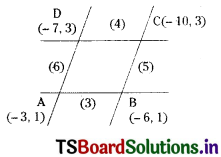
Vertex A: Solving (3) & (6)
From (3), y = 1
From (6), x + 2(1) + 1 = 0
⇒ x + 3 = 0
⇒ x = -3
Vertex A = (-3, 1)
Vertex B: Solving (3) & (5)
From (3), y = 1
From (5), x + 2(1) + 4 = 0
⇒ x + 6 = 0
⇒ x = -6
Vertex B = (-6, 1)
Vertex C: Solving (4) & (5)
From (4), y = 3
From (5), x + 2(3) + 4 = 0
⇒ x + 10 = 0
⇒ x = -10
Vertex C = (-10, 3)
Vertex D: Solving (4) & (6)
From (4), y = 3
From (6), x + 2(3) + 1 = 0
⇒ x + 7 = 0
⇒ x = -7
Vertex D = (-7, 3)
Vertices of a parallelogram are A(-3, 1), B(-6, 1), C(-10, 3) & D(-7, 3)
Now,
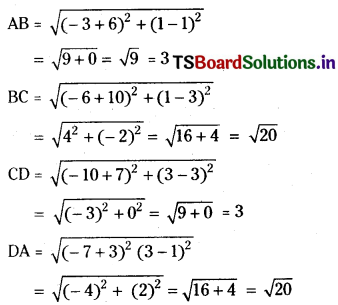
Question 17.
Show that the product of the perpendicular distances from the origin to the pair of straight lines represented by ax2 + 2hxy + by2 + 2gx + 2fy + c = 0 is \(\frac{|c|}{\sqrt{(a-b)^2+4 h^2}}\). [May ’98, ’93, ’90]
Solution:
ax2 + 2hxy + by2 + 2gx + 2fy + c = 0 represents two lines
l1x + m1y + n1 = 0 ……(1)
l2x + m2y + n2 = 0 …….(2)
ax2 + 2hxy + by2 + 2gx + 2fy + c = (l1x + m1y + n1)(l2x + m2y + n2)
Comparing the coefficients on both sides we get
a = l1l2, 2h = l1m2 + l2m1, 2g = l1n2 + l2n1, 2f = m1n1 + m2n2
The perpendicular distance from the origin to the straight line (1) is
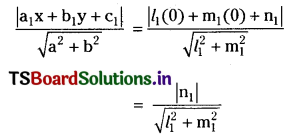
The perpendicular distance from the origin to the straight line (2) is
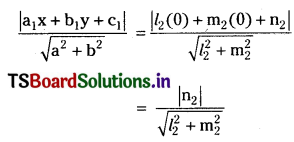
The product of the perpendicular distances
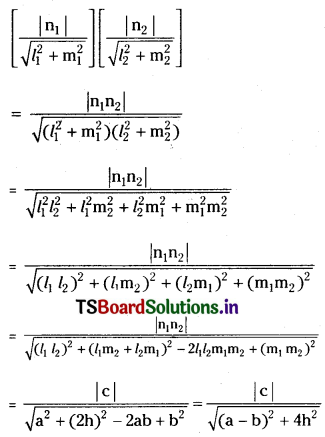
Question 18.
Find the angle between the lines joining the origin to the points of intersection of the curve x2 + 2xy + y2 + 2x + 2y – 5 = 0 and the line 3x – y + 1 = 0. [Mar. ’16 (AP), ’13, ’09, ’08, ’07; May ’14, ’13, ’11, ’04, ’80]
Solution:
Given equation of the curve is x2 + 2xy + y2 + 2x + 2y – 5 = 0 …….(1)
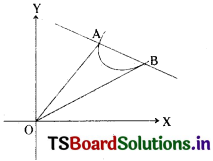
The equation of a straight line is
3x – y + 1 = 0
3x – y = -1
-3x + y = 1 ….(2)
Let, A, B are the points of intersection of the given line and the given curve.
Now, Homogenising the equation (1) with the help of (2)
The combined equation of \(\overline{\mathrm{OA}}\) and \(\overline{\mathrm{OB}}\) is
x2 + 2xy + y2 + 2x(1) + 2y(1) – 5(1)2 = 0
x2 + 2xy + y2 + 2x(-3x + y) + 2y(-3x + y) – 5(-3x + y)2 = 0
x2 + 2xy + y2 – 6x2 + 2xy – 6xy + 2y2 – 5(9x2 + y2 – 6xy) = 0
x2 + 2xy + y2 – 6x2 + 2xy – 6xy + 2y2 – 45x2 – 5y2 + 30xy = 0
x2(-5 – 45) + xy(4 – 6 + 30) + y2(1 + 2 – 5) = 0
x2(-50) + xy (+28) + y2(-2) = 0
-50x2 + 28xy – 2y2 = 0
50x2 – 28xy + 2y2 = 0
25x2 – 14xy + y2 = 0
which is the equation of the pairs of lines \(\overline{\mathrm{OA}}\) and \(\overline{\mathrm{OB}}\).
If ‘θ’ is the angle between the lines \(\overline{\mathrm{OA}}\) and \(\overline{\mathrm{OB}}\)
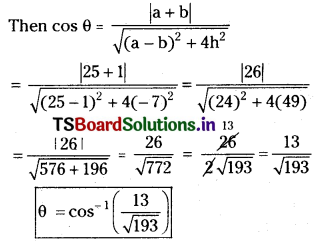
![]()
Question 19.
Find the value of k, if the lines joining the origin to the point of intersection of the curve 2x2 – 2xy + 3y2 + 2x – y – 1 = 0 and the line x + 2y = k are mutually perpendicular. [Mar. ’17 (AP), ’15 (TS), ’13 (Old) ’11, ’05, ’01; Mar. ’19 (AP & TS); May ’10, ’07, ’06; B.P.]
Solution:
Given the equation of the curve is 2x2 – 2xy + 3y2 + 2x – y – 1 = 0 ………(1)
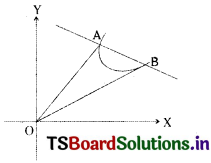
The equation of a straight line is x + 2y = k
\(\frac{x+2 y}{k}=1\) ……(1)
Let, A B be the points of intersection of the given line and the given curve.
Now, Homogenising the equation (1) with the help of (2)
The combined equation of \(\overline{\mathrm{OA}}\) and \(\overline{\mathrm{OB}}\) is
2x2 – 2xy + 3y2 + 2x(1) – y(1) – 1(1)2 = 0
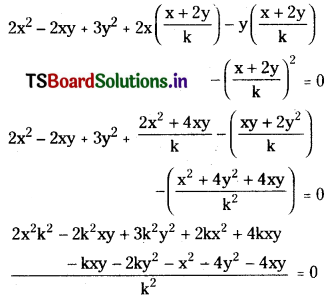
2k2x2 – 2k2xy + 3k2y2 + 2kx2 + 4kxy – kxy – 2ky2 – x2 – 4y2 – 4xy = 0
x2(2k2 + 2k – 1) + xy(-2k2 + 3k – 4) + y2(3k2 – 2k – 4) = 0
which is the equation of the pairs of lines \(\overline{\mathrm{OA}}\) and \(\overline{\mathrm{OB}}\).
Given that the lines \(\overline{\mathrm{OA}}\) and \(\overline{\mathrm{OB}}\) are perpendicular
then, a + b = 0
2k2 + 2k – 1 + 3k2 – 2k – 4 = 0
5k2 – 5 = 0
5k2 = 5
k2 = 1
k = ±1
Question 20.
Show that the lines joining the origin to the points of intersection of the curve x2 – xy + y2 + 3x + 3y – 2 = 0 and the straight line x – y – √2 = 0 are mutually perpendicular. [May ’15 (TS), ’12; Mar. ’15 (AP), ’12, ’08, ’03; Mar. ’18 (TS)]
Solution:
Given equation of the curve is x2 – xy + y2 + 3x + 3y – 2 = 0 ……..(1)
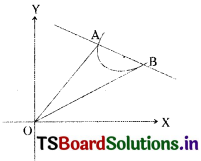
Equation of straight line is x – y – √2 = 0
x – y = √2
\(\frac{x-y}{\sqrt{2}}=1\) …….(2)
Let, A, B be the points of intersection of the given line and the given curve.
Now, Homogenising the equation (1) with the help of (2)
The combined equation of \(\overline{\mathrm{OA}}\) and \(\overline{\mathrm{OB}}\) is
x2 – xy + y2 + 3x(1) + 3y(1) – 2(1)2 = 0
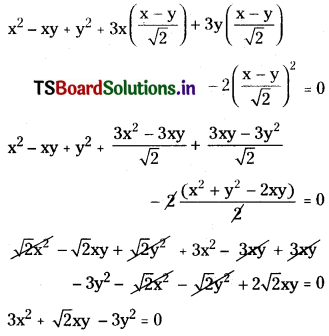
which is the equation of the pairs of lines \(\overline{\mathrm{OA}}\) and \(\overline{\mathrm{OB}}\).
Now a + b = 3 – 3 = 0
Since a + b = 0, then the lines \(\overline{\mathrm{OA}}\) and \(\overline{\mathrm{OB}}\) are mutually perpendicular.
Question 21.
Find the condition for the chord lx + my = 1 of the circle x2 + y2 = a2 (whose centre is the origin) to subtend a right angle at the origin. [Mar. ’14, ’13]
Solution:
Given equation of the curve is x2 + y2 = a2 ………(1)
Equation of the straight line is lx + my = 1 ……..(2)

Let A, B be the point of intersection of the given line and the given curve.
Now, Homogenising the equation (1) with the help of (2)
The combined equation of \(\overline{\mathrm{OA}}\) and \(\overline{\mathrm{OB}}\) is
x2 + y2 = a2(1)
x2 + y2 = a2(lx + my)2
x2 + y2 = a2(l2x2 + m2y2 + 2lmxy)
x2 + y2 = a2l2x2 + a2m2y2 + 2a2lmxy
a2l2x2 + a2m2y2 + 2a2lmxy – x2 – y2 = 0
x2(a2l2 – 1) + xy(2a2lm) + y2(a2m2 – 1) = 0
which is the equation of the pairs of lines \(\overline{\mathrm{OA}}\) and \(\overline{\mathrm{OB}}\).
Given that, the lines \(\overline{\mathrm{OA}}\) and \(\overline{\mathrm{OB}}\) are perpendicular.
Then, a + b = 0
a2l2 – 1 + a2m2 – 1 = 0
a2(l2 + m2) – 2 = 0
a2(l2 + m2) = 2
which is the required condition.
Question 22.
Find the condition for the lines joining the origin to the points of intersection of the circle x2 + y2 = a2 and the line lx + my = 1 to coincide. [Mar. ’17 (TS); May ’03]
Solution:
Given, equation of the curve is x2 + y2 = a2 ……….(1)
Equation of the straight line is lx + my = 1 ……….(2)
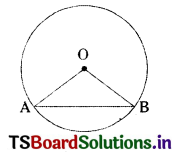
Let A and B be the point of intersection of the given line and the given curve.
Now, Homogenising the equation (1) with the help of (2)
The combined equation of \(\overline{\mathrm{OA}}\) and \(\overline{\mathrm{OB}}\) is
x2 + y2 = a2(1)
x2 + y2 = a2(lx + my)2
x2 + y2 = a2(l2x2 + m2y2 + 2lmxy)
x2 + y2 = a2l2x2 + a2m2y2 + 2a2lmxy
a2l2x2 + a2m2y2 + 2a2lmxy – x2 – y2 = 0
x2(a2l2 – 1) + xy(2a2lm) + y2(a2m2 – 1) = 0
Which is the equation of the pairs of lines \(\overline{\mathrm{OA}}\) and \(\overline{\mathrm{OB}}\)
Given that the lines \(\overline{\mathrm{OA}}\) and \(\overline{\mathrm{OB}}\) coincide.
Then, h2 = ab
(a2lm)2 = (a2l2 – 1)(a2m2 – 1)
a4l2m2 = a4l2m2 – a2l2 – a2m2 + 1
a2l2 + a2m2 = 1
a2(l2 + m2) = 1
Which is the required condition.
![]()
Question 23.
Find the equations of the straight lines bisecting the angles between the lines 7x + y + 3 = 0 and x – y + 1 = 0. [May ’05]
Solution:
Given the equation of the straight lines are
7x + y + 3 = 0 ……..(1)
x – y + 1 = 0 ……..(2)
Equations of the bisectors of the angles between the lines (1) & (2) are
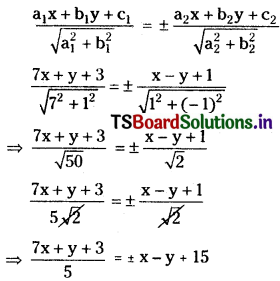
7x + y + 3 + 5(x – y + 1) = 0
7x + y + 3 + 5x – 5y + 5 = 0
2x + 6y – 2 = 0
x + 3y – 1 = 0
7x + y + 3 – 5(x – y + 1) = 0
7x + y + 3 – 5x + 5y – 5 = 0
12x – 4y + 8 = 0
3x – y + 2 = 0
∴ The equation of the bisectors of the angle between the lines (1) & (2) is x + 3y – 1 = 0, 3x – y + 2 = 0.
Question 24.
If ax2 + 2hxy + by2 = 0 represents two straight lines such that the slope of one line is twice the slope of the other, prove that 8h2 = 9ab. [May ’96]
Solution:
The given equation of the pair of lines is ax2 + 2hxy + by2 = 0.
Since the slope of one line is twice the slope of the other, then the slopes of the two lines represented by (1) are m, 2m.
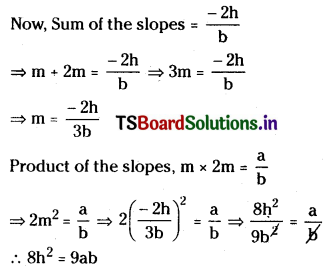
Question 25.
If one line of the pair of lines ax2 + 2hxy + by2 = 0 bisects the angle between the coordinate axes, prove that (a + b)2 = 4h2. [May ’04]
Solution:
Given, equation of the pair of lines is ax2 + 2hxy + by2 = 0 ………(1)
The equation of the X-axis is y = 0
The equation of the Y-axis is x = 0
∴ Equations of the bisectors of the angles between the coordinate axes are
\(\frac{\mathrm{a}_1 \mathrm{x}+\mathrm{b}_1 \mathrm{y}+\mathrm{c}_1}{\sqrt{\mathrm{a}_1^2+\mathrm{b}_1^2}}=\pm \frac{\mathrm{a}_2 \mathrm{x}+\mathrm{b}_2 \mathrm{y}+\mathrm{c}_2}{\sqrt{\mathrm{a}_2^2+\mathrm{b}_2^2}}\)
\(\frac{y}{\sqrt{1^2}}=\pm \frac{x}{\sqrt{1^2}}\)
y = ±x
y = x and y = -x
∴ Equations of the bisectors of the angles between the coordinate axes are y = x and y = -x.
Case 1: If one line of the pair of lines ax2 + 2hxy + hy2 = 0 is y = x
Substitute y = x in equation (1), and we get
ax2 + 2hx(x) + b(x)2 = 0
⇒ a + 2h + b = 0
⇒ a + b = -2h ………(2)
Case 2: If one line of the pair of lines is y = -x
Substitute y = -x in equation (1), and we get
ax2 + 2hx(-x) + b(-x)2 = 0
⇒ ax2 – 2hx2 + bx2 = 0
⇒ a – 2h + b = 0
⇒ a + b = 2h ……..(2)
From (2) & (3)
a + b = ±2h
Squaring on both sides
(a + b)2 = 4h2
Some More Maths 1B Pair of Straight Lines Important Questions
Question 26.
Find the centroid and the area of the triangle formed by the lines 2y2 – xy – 6x2 = 0, x + y + 4 = 0. [May ’03]
Solution:
Given the equation of the pair of lines is 2y2 – xy – 6x2 = 0
2y2 – 4xy + 3xy – 6x2 = 0
2y(y – 2x) + 3x(y – 2x) = 0
(y – 2x) (2y + 3x) = 0
y – 2x = 0 (or) 2y + 3x = 0
2x – y = 0 …….(1), 3x + 2y = 0 ……..(2)
The third equation is x + y + 4 = 0 ………(3)
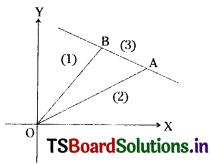
∴ Vertex O: The point of intersection of (1) & (2) is O = (0, 0)
Vertex A: Solving (1) & (3)
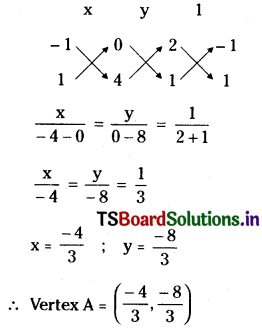
Vertex B: Solving (2) & (3)
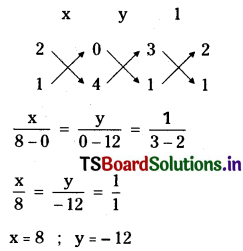
∴ Vertex B = (8, -12)
∴ Vertices of a triangle OAB are O = (0, 0), A(\(\frac{-4}{3}, \frac{-8}{3}\)), B = (8, -12)
Centroid of triangle
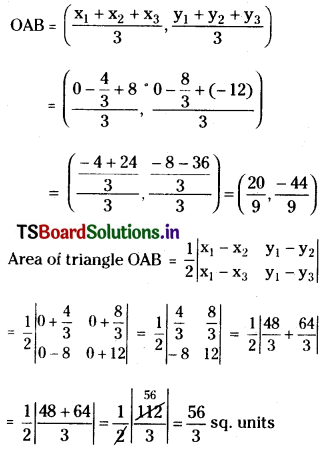
![]()
Question 27.
Find the centroid and area of the triangle formed by the lines 3x2 – 4xy + y2 = 0, 2x – y = 6.
Solution:
Given the equation of the pair of lines is
3x2 – 4xy + y2 = 0
3x2 – 3xy – xy + y2 = 0
3x(x – y) – y(x – y) = 0
(x – y) (3x – y) = 0
x – y = 0 ……..(1), 3x – y = 0 ………(2)
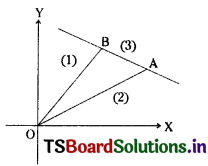
The third equation is 2x – y – 6 = 0 …….(3)
∴ Vertex O: The point of intersection of (1) & (2) is O = (0, 0)
Vertex A: Solving (1) & (3)
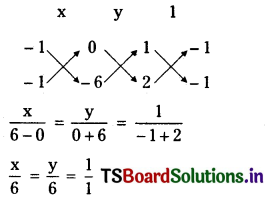
x = 6; y = 6
∴ Vertex A = (6, 6)
Vertex B: Solving (2) & (3)
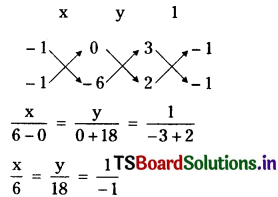
x = -6; y = -18
Vertex B = (-6, -18)
∴ Vertices of a triangle OAB are O = (0, 0), A = (6, 6), B = (-6, -18).
Centroid of triangle
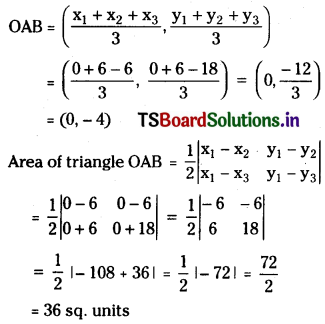
Question 28.
Show that the straight lines represented by (x + 2a)2 – 3y2 = 0 and x = a form an equilateral triangle. [Mar. ’03]
Solution:
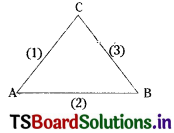
Given equation of the pair of lines is (x + 2a)2 – 3y2 = 0
⇒ (x + 2a)2 – (√3y)2 = 0
⇒ (x + 2a + √3y) (x + 2a – √3y) = 0
⇒ x + 2a + √3y = 0, x – √3y + 2a = 0
⇒ x + √3y + 2a = 0, x – √3y + 2a = 0
∴ This equation represents the lines
x + √3y + 2a = 0 ……(1)
x – √3y + 2a = 0 ……….(2)
Let the given equation of the straight line is x = a ………(3)
If A is an angle between (1) & (2) then
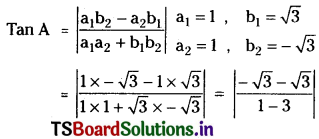
\(\left|\frac{-2 \sqrt{3}}{-2}\right|=|\sqrt{3}|\)
A = 60°
If B is an angle between lines (2) & (3) then
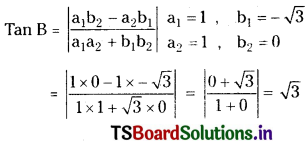
B = 60°
If C is the third angle then C = 180° – (60° + 60°)
= 180° – 120°
= 60°
∴ A = B = C = 60°
∴ The lines (1), (2), (3) form an equilateral triangle.
Question 29.
Show that the straight lines represented by 3x2 + 48xy + 23y2 = 0 and 3x – 2y + 13 = 0 form an equilateral triangle of area \(\frac{13}{\sqrt{3}}\) sq. units.
Solution:
Given the equation of the pair of lines is 3x2 + 48xy + 23y2 = 0
Comparing with ax2 + 2hxy + by2 = 0,
we get a = 3, 2h = 48 ⇒ h = 24, b = 23
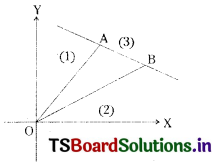
The given equation represents the two lines that are
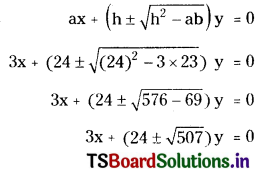
3x + (24 + √507)y = 0, 3x + (24 – √507)y = 0
∴ This equation represents the lines
3x + (24 + √507)y = 0 ……….(1)
3x + (24 – √507)y = 0 ………..(2)
Let the given equation of the straight line is 3x – 2y + 13 = 0 …….(3)
Let A is an angle between (1) & (3) then
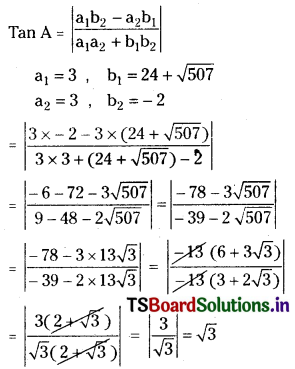
∴ A = 60°
If B is an angle between lines (2) & (3) then
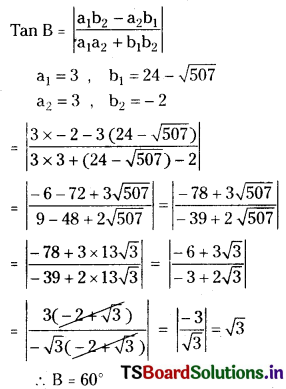
If O is the third angle then
O = 180° – (A + B)
= 180° – (60° + 60°)
= 180° – 120°
= 60°
∴ O = A = B = 60°
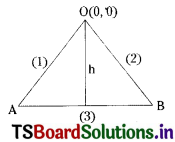
∴ The lines (1), (2), (3) form an equilateral triangle.
The length of the altitude of the triangle h = the perpendicular distance from the origin O to the line (3)
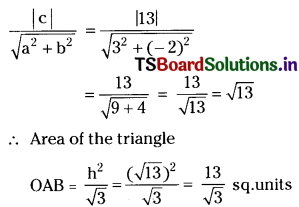
![]()
Question 30.
Prove that the equation 3x2 + 7xy + 2y2 + 5x + 5y + 2 = 0 represents a pair of straight lines and find the coordinates of the point of intersection.
Solution:
Given equation is 3x2 + 7xy + 2y2 + 5x + 5y + 2 = 0
Comparing the given equation with ax2 + 2hxy + by2 + 2gx + 2fy + c = 0, we get
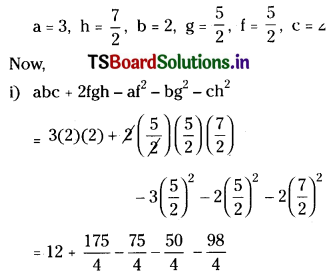
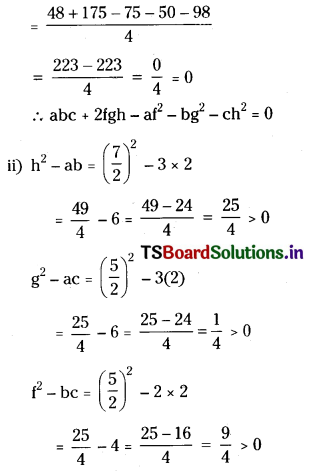
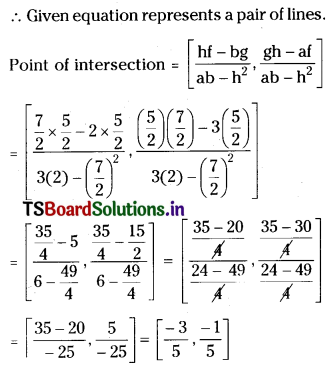
Question 31.
If x2 + xy – 2y2 + 4x – y + k = 0 represents a pair of straight lines, find k.
Solution:
Given equation is x2 + xy – 2y2 + 4x – y + k = 0
Comparing the given equation with ax2 + 2hxy + by2 + 2gx + 2fy + c = 0, we get
a = 1, h = \(\frac{1}{2}\), b = -2, g = 2, f = \(\frac{-1}{2}\), c = k
Since the given equation represents a pair of lines then abc + 2fgh – af2 – bg2 – ch2 = 0
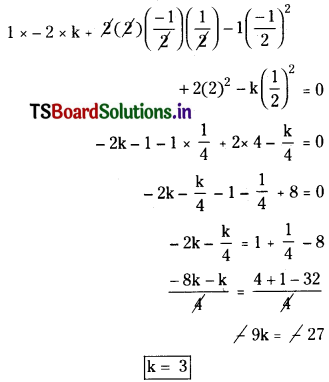
Question 32.
Find the distance between the pairs of parallel straight lines 9x2 – 6xy + y2 + 18x – 6y + 8 = 0. [May ’03]
Solution:
Given, equation is 9x2 – 6xy + y2 + 18x – 6y + 8 = 0
Comparing the given equation with ax2 + 2hxy + by2 + 2gx + 2fy + c = 0, we get
a = 9, h = -3, b = 1, g = 9, f = -3, c = 8
The distance between the parallel lines
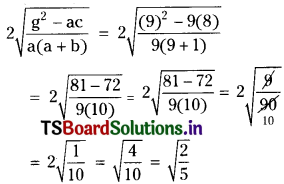
Question 33.
Find the distance between the pairs of parallel straight lines x2 + 2√3xy + 3y2 – 3x – 3√3y – 4 = 0. [May ’03]
Solution:
Given, equation is x2 + 2√3xy + 3y2 – 3x – 3√3y – 4 = 0
Comparing the given equation with ax2 + 2hxy + by2 + 2gx + 2fy + c = 0, we get
a = 1, h = √3, b = 3, g = \(\frac{-3}{2}\), f = \(\frac{-3 \sqrt{3}}{2}\), c = -4
The distance between the parallel lines
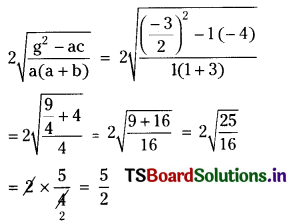
Question 34.
Show that the two pairs of lines 3x2 + 8xy – 3y2 = 0 and 3x2 + 8xy – 3y2 + 2x – 4y – 1 = 0 form a square.
Solution:
Given equations of the pair of lines are
3x2 + 8xy – 3y2 = 0 ……..(1)
3x2 + 8xy – 3y2 + 2x – 4y – 1 = 0 ………(2)
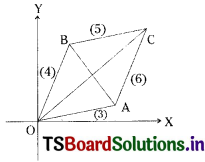
Now, 3x2 + 8xy – 3y2 = 0
3x2 + 9xy – xy – 3y2 = 0
3x(x + 3y) – y(x + 3y) = 0
(x + 3y)(3x – y) = 0
x + 3y = 0 (or) 3x – y = 0
Equation (1) represents the two lines that are
x + 3y = 0 ………(3), 3x – y = 0 ………(4)
Now 3x2 + 8xy – 3y2 + 2x – 4y – 1 = (x + 3y + k) (3x – y + l)
Comparing the coefficient of x, on both sides we get l + 3k = 2
Comparing the coefficient of y on both sides we get 3l – k = -4
Solving these two equations we get
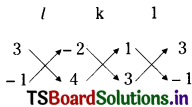
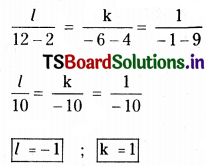
∴ Equation (2) represents the lines that are
x + 3y + 1 = 0 ……..(5)
3x – y – 1 = 0 ……….(6)
∴ The equations of the four lines are
x + 3y = 0 ……….(3)
3x – y = 0 ………..(4)
x + 3y + 1 = 0 ……….(5)
3x – y – 1 = 0 ……….(6)
The equations (3) & (5); (4) & (6) are parallel.
The equations (3) & (4); (5) & (6) are perpendicular.
∴ The four lines form a rectangle.
The distance between the parallel lines (3) & (5) is
\(\frac{\left|c_1-c_2\right|}{\sqrt{a^2+b^2}}=\frac{|0-1|}{\sqrt{1^2+3^2}}=\frac{|-1|}{\sqrt{1+9}}=\frac{1}{\sqrt{10}}\)
The distance between the parallel lines (4) & (6) is
\(\frac{\left|c_1-c_2\right|}{\sqrt{a^2+b^2}}=\frac{|0+1|}{\sqrt{3^2+(-1)^2}}=\frac{1}{\sqrt{9+1}}=\frac{1}{\sqrt{10}}\)
∴ Given lines form a square.
![]()
Question 35.
Find the lines joining the origin to the points of intersection of the curve 7x2 – 4xy + 8y2 + 2x – 4y – 8 = 0 with the straight line 3x – y = 2 and also the angle between them. [Mar. ’18 (AP); May ’01, ’98; Mar. ’00]
Solution:
Given the equation of the curve is
7x2 – 4xy + 8y2 + 2x – 4y – 8 = 0 ………(1)
The equation of a straight line is 3x – y = 2
\(\frac{3 x-y}{2}\) = 1 ……..(2)
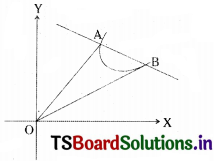
Let A and B be the points of intersection of the given line and curve.
Now, Homogenising the equation (1) with the help of (2)
The combined equation of \(\overline{\mathrm{OA}}\) and \(\overline{\mathrm{OB}}\) is
7x2 – 4xy + 8y2 + 2x(1) – 4y(1) – 8(1)2 = 0
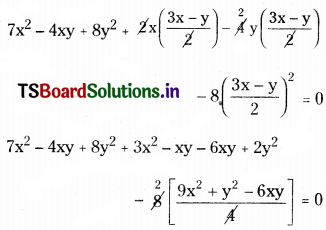
7x2 – 4xy + 8y2 + 3x2 – xy – 6xy + 2y2 – 18x2 – 2y2 + 12xy = 0
x2(7 + 3 – 18) + xy(-4 – 1 – 6 + 12) + y2(8 + 2 – 2) = 0
x2(-8) + xy(1) + y2(8) = 0
-8x2 + xy + 8y2 = 0
8x2 – xy – 8y2 = 0
which is the equation of the pairs of lines \(\overline{\mathrm{OA}}\) and \(\overline{\mathrm{OB}}\).
Here, a = 8, b = -8
Now, a + b = 8 – 8 = 0
Since, a + b = 0, the lines \(\overline{\mathrm{OA}}\) and \(\overline{\mathrm{OB}}\) are mutually perpendicular.
∴ Angle between the lines = 90°
Question 36.
Find the equation of the bisector of the acute angle between the lines 3x – 4y + 7 = 0 and 12x + 5y – 2 = 0.
Solution:
Given equations of the straight lines are
3x – 4y + 7 = 0 ……….(1)
12x + 5y – 2 = 0 ………(2)
Equations of bisectors of the angles between the lines (1) & (2) are
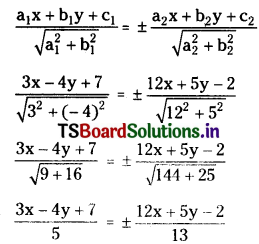
13(3x – 4y + 7) = 5(12x + 5y – 2)
39x – 52y + 91 = 60x + 25y – 10
21x + 77y – 101 = 0
\(\frac{3 x-4 y+7}{5}=\frac{-12 x-5 y+2}{13}\)
39x – 52y + 91 + 60x + 25y – 10 = 0
99x – 27y + 81 = 0
11x – 3y + 9 = 0
∴ The equations of the bisectors of the angles between lines (1) & (2) are
21x + 77y – 101 = 0 ……….(3)
11x – 3y + 9 = 0 ……….(4)
Consider the lines
3x – 4y + 7 = 0 ……..(1)
11x – 3y + 9 = 0 ……..(4)
If θ is the angle between (1) & (4) then
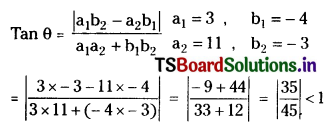
∴ 11x – 3y + 9 = 0 is the acute angle bisector.
Question 37.
Show that the equation of the pair of lines bisecting the angle between the pair of bisectors of the angles between the pair of lines ax2 + 2hxy + by2 = 0 is (a – b) (x2 – y2) + 4hxy = 0.
Solution:
Given, equation of the pair of lines is ax2 + 2hxy + by2 = 0 ……(1)
The equation to the pair of bisectors of angles between (1) is
h(x2 – y2) = (a – b)xy
hx2 – hy2 = (a – b)xy
hx2 – (a – b)xy – hy2 = 0 ……….(2)
Now comparing (2) with ax2 + 2hxy + by2 = 0, we get
a = h, h = \(\frac{-(a-b)}{2}\), b = -h
The equation to the pair of bisectors of angles between (2) is
h(x2 – y2) = (a – b)(xy)
\(\frac{-(a-b)}{2}\)(x2 – y2) = (h + h)xy
-(a – b)(x2 – y2) = 4hxy
∴ (a – b)(x2 – y2) + 4hxy = 0
Question 38.
If the pairs of lines represented by ax2 + 2hxy + by2 = 0 and ax2 + 2hxy + by2 + 2gx + 2fy + c = 0 form a rhombus, prove that (a – b)fg + h(f2 – g2) = 0.
Solution:
Given equations o the pair of lines are
ax2 + 2hxy + by2 = 0 ………..(1)
ax2 + 2hxy + by2 + 2gx + 2fy + c = 0 ……..(2)
Let \(\overline{\mathrm{OA}}, \overline{\mathrm{OB}}\) be the pair of straight lines given by (1).
\(\overline{\mathrm{AC}}, \overline{\mathrm{BC}}\) be the pair of lines given by (2).
Since the lines represented by (1) are parallel to the lines represented by (2), then OACB is a parallelogram.
Now, ‘C’ is the point of intersection of (2).
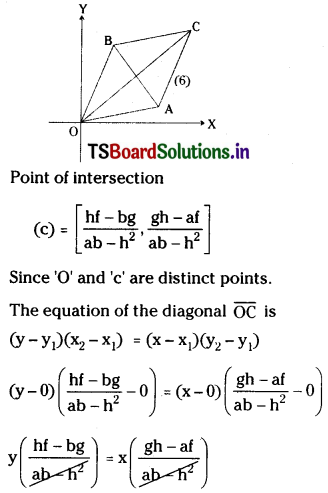
(gh – af)x – (hf – bg)y = 0
Since, ‘A’ is a point on the locus (1) & (2),
the coordinates of A satisfy the equation (1) – (2) = 0.
Similarly, the coordinates of B also satisfy the equation (1) – (2) = 0.
Now, (1) – (2) = 0
⇒ ax2 + 2hxy + by2 – ax2 – 2hxy – by2 – 2gx – 2fy – c = 0
⇒ -(2gx + 2fy + c) = 0
⇒ 2gx + 2fy + c = 0
This is the linear equation in which x and y represent a line.
Hence (1) – (2) is the equation of diagonal \(\overline{\mathrm{AB}}\).
Since OACB is a rhombus, then the diagonals \(\overline{\mathrm{OC}}\) and \(\overline{\mathrm{AB}}\) are perpendicular to each other.
i.e., slope of \(\overline{\mathrm{OC}}\) × slope of \(\overline{\mathrm{AB}}\) = -1
\(\frac{-(g h-a f)}{-(h f-b g)} \times \frac{- 2 g}{2 f}=-1\)
\(\frac{g(g h-a f)}{f(h f-b g)}\) = 1
g(gh – af) = f(hf – bg)
g2h – afg = f2h – bgf
f2h – bfg – g2h + afg = 0
fg(a – b) + h(f2 – g2) which is the required condition.
![]()
Question 39.
Find the value of k, if the equation 2x2 + kxy – 6y2 + 3x + y + 1 = 0 represents a pair of straight lines. Find the point of intersection of the lines and the angle between the straight lines for this value of k.
Solution:
Given equation is 2x2 + kxy – 6y2 + 3x + y + 1 = 0.
Comparing the given equation with ax2 + 2hxy + by2 + 2gx + 2fy + c = 0,
we get a = 2, h = \(\frac{k}{2}\), b = -6, g = \(\frac{3}{2}\), f = \(\frac{1}{2}\), c = 1
Since the given equation represents a pair of straight lines then
abc + 2fgh – af2 – bg2 – ch2 = 0
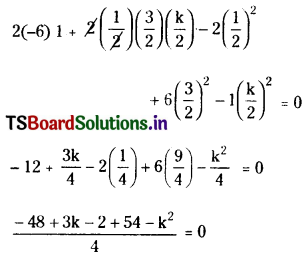
-k2 + 3k + 4 = 0
k2 – 3k – 4 = 0
k2 – 4k + k – 4 = 0
k(k – 4) + 1(k – 4) = 0
(k – 4)(k + 1) = 0
k = 4 or -1
For k = 4, then a = 2, h = 2, b = -6, g = \(\frac{3}{2}\), f = \(\frac{1}{2}\), c = 1
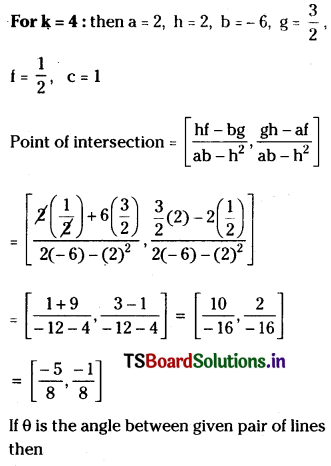
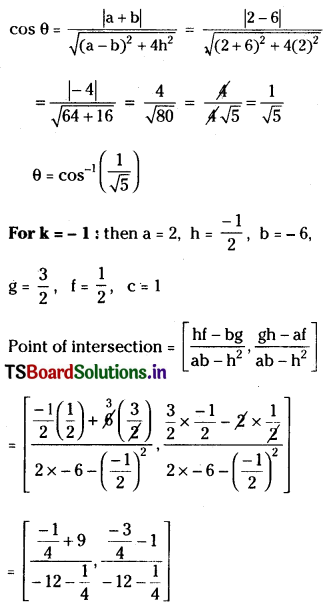
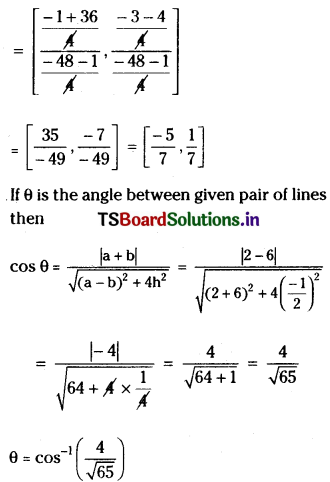
Question 40.
Show that the lines x2 + 2xy – 35y2 – 4x + 44y – 12 = 0 and 5x + 2y – 8 = 0 are concurrent.
Solution:
Given equation is x2 + 2xy – 35y2 – 4x + 44y – 12 = 0
Comparing the given equation with ax2 + 2hxy + by2 + 2gx + 2fy + c = 0, we get
a = 1, h = 1, b = -35, g = -2, f = 22, c = -12
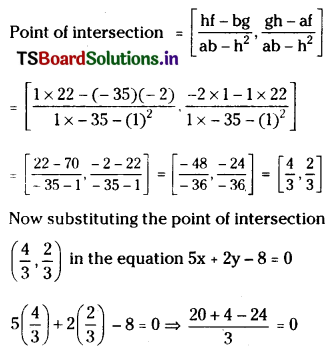
⇒ 0 = 0
∴ The given lines are concurrent.
![]()
Question 41.
Write down the equation of the pair of straight lines joining the origin to the points of intersection of line 6x – y + 8 = 0 with the pair of straight lines 3x2 + 4xy – 4y2 – 11x + 2y + 6 = 0. Show that the lines so obtained make equal angles with the coordinate axes. [May ’15 (AP)]
Solution:
Given the equation of the curve is
3x2 + 4xy – 4y2 – 11x + 2y + 6 = 0 ………(1)
Equation of straight line is 6x – y + 8 = 0
⇒ 6x – y = -8
⇒ \(\frac{6 x-y}{-8}\) = 1 ………(2)
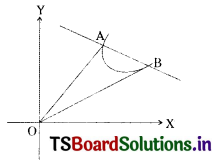
Let, A, B are the points of intersection of the given line and the given curve.
Now, Homogenising equation (1) with the help of (2).
The combined equation of \(\overline{\mathrm{OA}}\) and \(\overline{\mathrm{OB}}\) is
3x2 + 4xy – 4y2 – 11x(1) + 2y(1) + 6(1)2 = 0
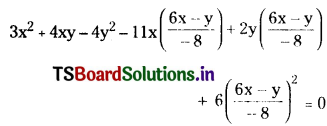
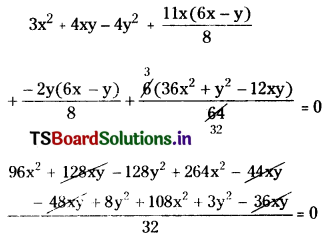
x2(468) + y2(-117) = 0
x2(468) – y2(117) = 0
4x2 – y2 = 0
which is the equation of the pair of lines \(\overline{\mathrm{OB}}\) and \(\overline{\mathrm{OB}}\).
Comparing this equation with ax2 + 2hxy + by2 = 0,
a = 4, h = 0, b = -1
The equation to the pair of bisectors of angles between 4x2 – y = 0 is h(x2 – y2) = (a – b)(xy)
0(x2 – y2) – (4 + 1)xy
5xy = 0
xy = 0
x = 0, y = 0
which are the equations of the coordinate axes.
The lines \(\overline{\mathrm{OA}}\) and \(\overline{\mathrm{OB}}\) makes equal angles with the coordinate axes.